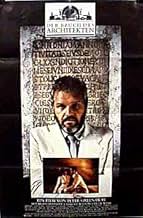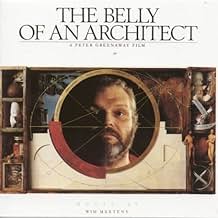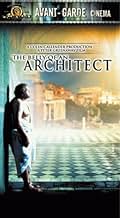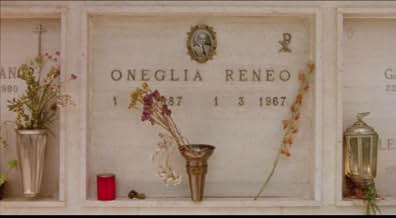NOTE IMDb
6,9/10
6,5 k
MA NOTE
Ajouter une intrigue dans votre langueAn architect supervising an exhibition starts to have mysterious stomach pains while his life slowly falls apart.An architect supervising an exhibition starts to have mysterious stomach pains while his life slowly falls apart.An architect supervising an exhibition starts to have mysterious stomach pains while his life slowly falls apart.
- Réalisation
- Scénario
- Casting principal
- Récompenses
- 2 nominations au total
Marino Masé
- Trettorio
- (as Marino Mase)
Avis à la une
Starring Brian Dennehy, an unusual actor for a Peter Greenaway film, as Kracklite, an architect, a career we don't often see explored in cinema, Greenaway's 'Belly of an Architect' is somehow bigger and more emotionally ambitious than most of his other works, which lack human resonance. In his other films, the characters are uniformly British and so Greenaway's coldness and archness toward them is indicative of a general misanthropy. Here, it's aimed squarely at Romans, whose loose morals and carnivorous practices contrast with the enormity of Kracklite's ego and generosity of spirit. His stomach is being eaten away by some unknown illness or cancer, and this serves as a metaphor for his ego being eaten away by the carnivorousness of Roman culture. His wife, his identity (which is a vicarious one, given his devotion/debt to his idol, Bouleé) and his work are being repossessed by the conquestful Roman carnivores who aim to destroy him simply for the material gain of taking what is so ostentatiously his. But his devotion to Bouleé, his need to make Bouleé's work more widely known, is not a singular or altruistic act; the exhibition he is organizing will make Bouleé more commercial and accessible, but it will also be an addendum to his own career, a manifestation of his ego. His diary is written in the form of letters to Bouleé, to whom he is almost praying as his own personal God. And his devotion to this God is not a selfless one, since Bouleé is so inexorably an element of his own identity.
Rome and its buildings are given a golden, postmodern glow, their clarity enhanced by Wim Mertens' musical score, which adds its own sunlight to the proceedings. But the sunlight that glows throughout Rome and permeates the aura of the film is an impersonal one, an indifferent one, as ancient as the ruins of Rome, which our Roman characters observe have been more useful and influential as ruins than they were prior. "They're better as ruines," a character observes. "Your imagination compensates for what you don't see, like a woman with clothes on." The Romans are depicted here as carnivores (and the word "carnivore" is used multiple times) who not only want to devour and repossess, but want to strip. Brian Dennehy's performance here is indeed stripped, larger than life, fiery. He explodes on screen, bringing the film into another realm, introducing emotional dimensions not often seen in the films of Greenaway; and in this, the film has a power that inhabits the movie's symmetrical form (mostly every shot is symmetrical), its architecture, and threatens to destroy it. The coldness that is typical of Greenaway, that architecturized godlessness, is at war with fiery human passion in all its flawed nakedness.
Greenaway's movies, in their arctic wit and obsession with symmetry, are cinema as architecture more so than storytelling, so 'The Belly of an Architect,' contrary to the claim by many that it's his most mainstream and therefore weakest work, is perhaps his most appropriate film, and maybe his best
Rome and its buildings are given a golden, postmodern glow, their clarity enhanced by Wim Mertens' musical score, which adds its own sunlight to the proceedings. But the sunlight that glows throughout Rome and permeates the aura of the film is an impersonal one, an indifferent one, as ancient as the ruins of Rome, which our Roman characters observe have been more useful and influential as ruins than they were prior. "They're better as ruines," a character observes. "Your imagination compensates for what you don't see, like a woman with clothes on." The Romans are depicted here as carnivores (and the word "carnivore" is used multiple times) who not only want to devour and repossess, but want to strip. Brian Dennehy's performance here is indeed stripped, larger than life, fiery. He explodes on screen, bringing the film into another realm, introducing emotional dimensions not often seen in the films of Greenaway; and in this, the film has a power that inhabits the movie's symmetrical form (mostly every shot is symmetrical), its architecture, and threatens to destroy it. The coldness that is typical of Greenaway, that architecturized godlessness, is at war with fiery human passion in all its flawed nakedness.
Greenaway's movies, in their arctic wit and obsession with symmetry, are cinema as architecture more so than storytelling, so 'The Belly of an Architect,' contrary to the claim by many that it's his most mainstream and therefore weakest work, is perhaps his most appropriate film, and maybe his best
Why was this film made? Because someone talked Greenaway into trying to go mainstream. By this time, he had already made some of the most adventuresome films in history. This simple confection is sandwiched between `Zed and Two Noughts' and `Drowning by Numbers,' both of which are complex, intelligent, risky, erudite.
I can only imagine that he thought he could finance his serious work with a commercial success. Some might tag this as an accessible Greenaway film, but I hardly think it is Greenaway at all. Nor is the remarkable composer Nyman present.
All that remains are some lush compositions, studies in photographing monumental architecture, and these are pleasant enough. A subtext is fascist perfidy in architecture and the film takes a critical (visual) stance on Roman architecture. See here how all the buildings are from the emperors or Mussolini. No church architecture here which must have been a conscious omission for simplicity.
Everything about the physical fabric portrayed is dehumanizing, especially as compared to the containing space of the skin. As an architect myself, I can appreciate the message. It is a clever conceit, but it pales, utterly fades away, in comparison to his best: `The Falls,' and the `book' films.
I can only imagine that he thought he could finance his serious work with a commercial success. Some might tag this as an accessible Greenaway film, but I hardly think it is Greenaway at all. Nor is the remarkable composer Nyman present.
All that remains are some lush compositions, studies in photographing monumental architecture, and these are pleasant enough. A subtext is fascist perfidy in architecture and the film takes a critical (visual) stance on Roman architecture. See here how all the buildings are from the emperors or Mussolini. No church architecture here which must have been a conscious omission for simplicity.
Everything about the physical fabric portrayed is dehumanizing, especially as compared to the containing space of the skin. As an architect myself, I can appreciate the message. It is a clever conceit, but it pales, utterly fades away, in comparison to his best: `The Falls,' and the `book' films.
You always know going into a Peter Greenaway film that, for better or for worse, you are going to get something a bit left-field. The Belly of an Architect is really no different in this regard. This one tells the tale of an American architect who travels to Rome with his young wife to supervise an exhibition celebrating the 18th century architect Etienne-Louis Boullée. Very soon after arrival both he and his wife experience contrasting activity in their bellies, for him it is severe abdominal pains while she falls pregnant. To complicate matters, they soon begin affairs with other people. The film essentially then details the architects mental deterioration, which includes writing postcards to his long deceased doppelganger Boullée.
This one has to go down as one of Greenaway's more accessible films. It has an actual story that is underpinned by a good central performance from Brian Dennehy. But its maybe the very fact that it skirts so close to realistic drama that is one of the main problems, as Greenaway is usually best when he does precisely the opposite. The story is really quite boring and the acting aside from Dennehy not all that good – Chloe Webb being particularly flat as his wife; look out also for Stefania (Suspiria) Cassini sporting an unfamiliar cropped 80's barnet. The visuals, while certainly nicely composed, aren't all that memorable. Given that the setting is Rome, there are many shots of that cities peerless architecture, although that all gets almost a bit travelogue to a certain extent. I think this film, therefore, is one for Greenaway devotees almost exclusively as in order to get a lot out of it you have to be interested in his ideas. While I have liked several of his films, I can't deny that, even in the cases of the ones I liked most, his films can be somewhat annoying. Dennehy really helps draw us in to events though and makes a good stab at involving us but it's difficult to care too much about these stiff characters populating a narrative that is both distant and very cold emotionally. Boullée himself is a typically absurd Greenaway figure, in that very little of his architecture ever came to be built, so it's difficult to ever imagine a high profile retrospective of his work ever happening. His rounded, domed buildings mimic the belly of the title, as does his name. So there are many links and symmetries in the story if you are at all interested in that kind of thing. But, while some of the photography was nice and it did have a good score from one of the members of Kraftwerk, it was overall a little tedious for me.
This one has to go down as one of Greenaway's more accessible films. It has an actual story that is underpinned by a good central performance from Brian Dennehy. But its maybe the very fact that it skirts so close to realistic drama that is one of the main problems, as Greenaway is usually best when he does precisely the opposite. The story is really quite boring and the acting aside from Dennehy not all that good – Chloe Webb being particularly flat as his wife; look out also for Stefania (Suspiria) Cassini sporting an unfamiliar cropped 80's barnet. The visuals, while certainly nicely composed, aren't all that memorable. Given that the setting is Rome, there are many shots of that cities peerless architecture, although that all gets almost a bit travelogue to a certain extent. I think this film, therefore, is one for Greenaway devotees almost exclusively as in order to get a lot out of it you have to be interested in his ideas. While I have liked several of his films, I can't deny that, even in the cases of the ones I liked most, his films can be somewhat annoying. Dennehy really helps draw us in to events though and makes a good stab at involving us but it's difficult to care too much about these stiff characters populating a narrative that is both distant and very cold emotionally. Boullée himself is a typically absurd Greenaway figure, in that very little of his architecture ever came to be built, so it's difficult to ever imagine a high profile retrospective of his work ever happening. His rounded, domed buildings mimic the belly of the title, as does his name. So there are many links and symmetries in the story if you are at all interested in that kind of thing. But, while some of the photography was nice and it did have a good score from one of the members of Kraftwerk, it was overall a little tedious for me.
An American architect (Dennehy) comes to Rome with his wife to create an exhibition he's been working on for 10years. He is troubled though by a terrible pain in his stomach.
Like all Greenaway's projects, this is decidedly off kilter - though not as much as usual - with his usual structured picture framing and colour (red and green) and fabulous use of music. The wonderful soundtrack here is not by Nyman, but is very similar.
Dennehy is perfect in the lead role, but Chloe Webb as his wife puts in a rather strange stilted performance as his wife.
This starts slow but improves as it goes along as Dennehy's story unfolds. Not for everyone, but lovers of the great director will enjoy this, even if it is more orthodox than usual.
Like all Greenaway's projects, this is decidedly off kilter - though not as much as usual - with his usual structured picture framing and colour (red and green) and fabulous use of music. The wonderful soundtrack here is not by Nyman, but is very similar.
Dennehy is perfect in the lead role, but Chloe Webb as his wife puts in a rather strange stilted performance as his wife.
This starts slow but improves as it goes along as Dennehy's story unfolds. Not for everyone, but lovers of the great director will enjoy this, even if it is more orthodox than usual.
One of my favorite Greenaway films. Story, visuals, metaphor, acting, music...it's got it all. The visuals of Rome are stunning. Wim Mertens' musical accompaniment is brilliant and on par with any modern minimalist composition. After years of seeing his TV roles, I was completely floored by the depth and authenticity Brian Dennehey brought to the main character. I've watched this film at least a dozen times over the years and enjoy it thoroughly each time. Unlike a previous reviewer, I don't see the need to judge this film based on how much it resembles previous or subsequent Greenaway films. "Belly of An Architect" is not as abstract as some of the other Greenaway films, but that shouldn't be viewed as a negative. The film is great and rich in its own right. I highly recommend it.
Le saviez-vous
- AnecdotesBrian Dennehy was quoted after the release as saying "I've made lots of movies but only one film."
- GaffesWhen photocopying the picture of Augustus, Kracklite puts the picture in upside-down which would have given a blank copy. Additionally, it would not be possible to achieve the level of resolution of Augustus's abdomen from such a small picture.
- Citations
Caspasian Speckler: Your wife is very beautiful, Signor Kracklite, especially when she is pregnant.
Stourley Kracklite: Yes, that's right. She is pregnant. But not with your child, Speckler.
Caspasian Speckler: True. I'm very grateful to you for that. Your child, shall we say, is the most perfect contraceptive.
[Kracklite turns and punches Speckler in the nose]
- ConnexionsFeatured in Peter Greenaway (1992)
Meilleurs choix
Connectez-vous pour évaluer et suivre la liste de favoris afin de recevoir des recommandations personnalisées
- How long is The Belly of an Architect?Alimenté par Alexa
Détails
- Date de sortie
- Pays d’origine
- Langues
- Aussi connu sous le nom de
- The Belly of an Architect
- Lieux de tournage
- Sociétés de production
- Voir plus de crédits d'entreprise sur IMDbPro
Box-office
- Montant brut aux États-Unis et au Canada
- 287 725 $US
- Durée1 heure 59 minutes
- Couleur
- Mixage
- Rapport de forme
- 1.85 : 1
Contribuer à cette page
Suggérer une modification ou ajouter du contenu manquant

Lacune principale
By what name was Le Ventre de l'architecte (1987) officially released in India in English?
Répondre






























